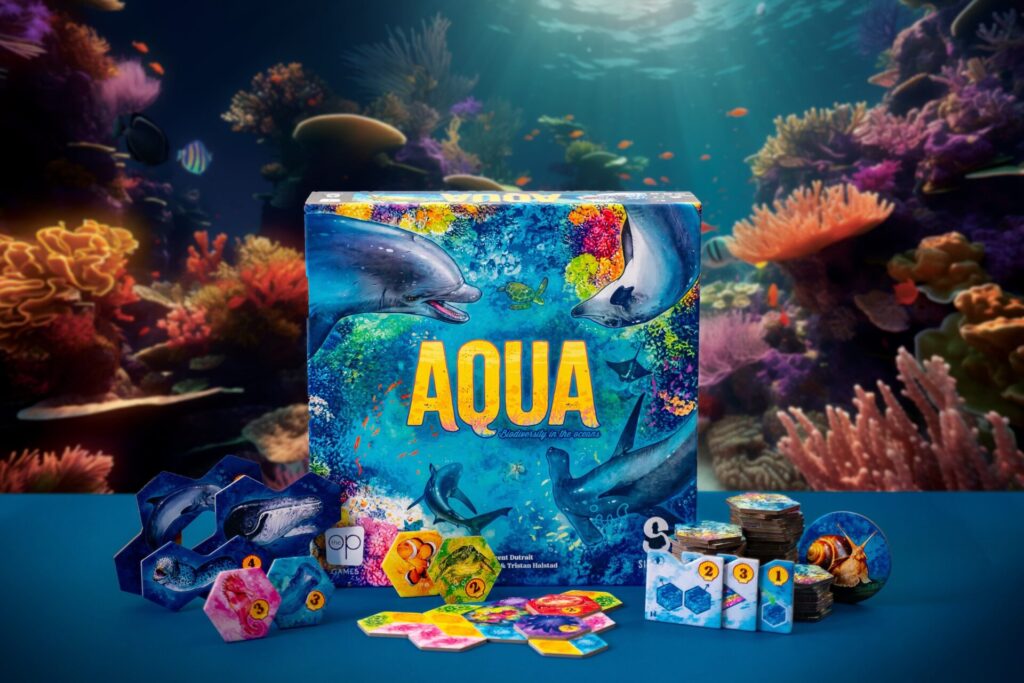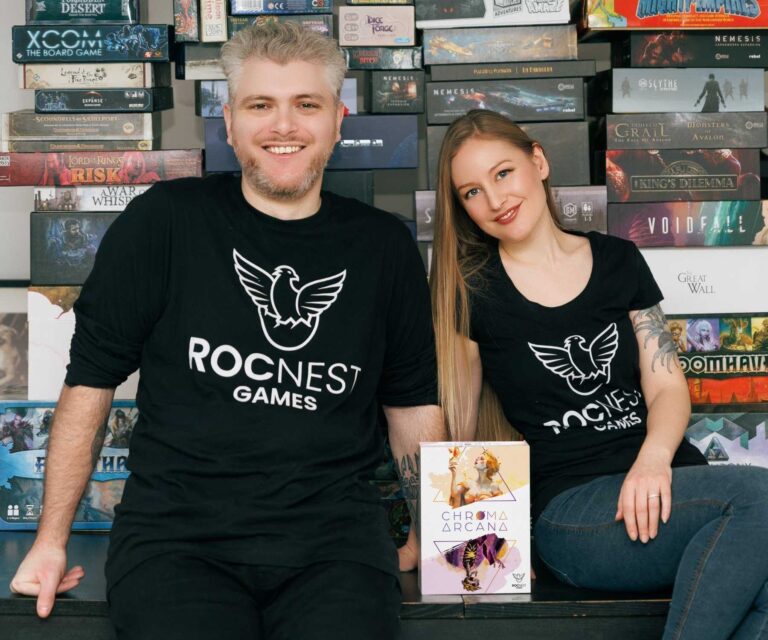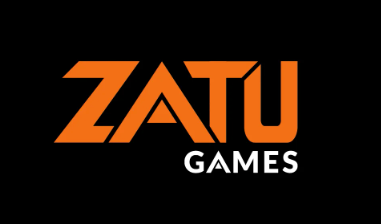
“The ride here wasn’t without its bumps:” Heat: Pedal to the Metal co-designer Asger Harding Granerud on his journey from board game distributor and retailer to BGG Top 40 designer
Heat: Pedal to the Metal co-designer Asger Harding Granerud has completed a full lap of the board game industry since he began designing games just over a decade ago, having launched a distributor, retail shop and design studio in addition to seeing his motor racing co-design accelerate into the BoardGameGeek Top 40. Granerud sat down with BoardGameWire to discuss his learning curve as a designer and publisher, the challenges of running a three-person indie studio, and how to avoid common pitfalls in bringing your game to market.
Hi Asger! Thanks so much for speaking with us, really looking forward to hearing what you have to say. Many people will know you best as the designer or co-designer of games like Heat: Pedal to the Metal, Flamme Rouge and Copenhagen. But you’ve also founded a board game distributor and co-founded a board game design studio, a retail shop and a publisher. What came first?
Thanks for reaching out, and for taking an interest in our endeavours!
Chronologically I started designing games in 2012, but I had founded the distributor Spilbraet.dk in 2014 before my first games Flamme Rouge and 13 Days were published in 2016. In 2017 I co-founded the retail shop Braet & Brikker in the Fisketorvet shopping centre in Copenhagen, Denmark. My business partner and co-designer Daniel Skjold Pedersen and I have done all our designs collaboratively since 2014, but our shared company Sidekick Studio wasn’t founded till 2018 where I also divested from the distributor and retailer (though they are still my babies in spirit!).
In 2019 Daniel and I upped the stakes and started a small indie publishing company called Sidekick Games, and brought in Dan Halstad to help run it. We currently publish a single Generational Game a year.
That’s a busy LinkedIn page! What was it that persuaded you to divest from the distribution and retail side of things in 2018 – did the success of Flamme Rouge play a part in that?
A mix of factors all in all. I’m more of an entrepreneur than a daily manager, so partly I needed a change of pace as the core businesses had solidified. The distributor also needed to begin hiring staff to grow, and I don’t particularly enjoy managing people.

At that point in time Flamme Rouge’s success had been on an upward trajectory, and I obviously hoped it would continue. Daniel and I had also signed a bunch of games we knew were coming that year and coming years. Games we had signed with bigger and bigger publishers to boot.
So I took the leap of faith into full time game design, with all the freedom it entailed.
What were your initial hopes and expectations upon setting up full-time as a game designer – and did the first year or so go to plan?
You’re shooting big questions, Mike. I like it!
I had several hopes tied up in game designing full time. I love games, I love creation, I love new ideas, and I love finding potential in things. I don’t want a boss, and I don’t want to be someone’s boss either. Game design still to this day seems like the perfect match for my wishes, and considering every game being different, I doubt it will ever grow stale. I feel simultaneously humbled and proud that I somehow managed this.
However the ride here wasn’t without its bumps. Soon after going full time we had positive news by Days of Wonder picking up Heat and we also got our first Kinderspiel des Jahres nomination (Panic Mansion). Delays and the pandemic really made it tough though, so getting out of that slump and having Heat take off was pretty amazing. Our first three projects as a publisher also ended up retrospectively being learning experiences, but the fourth and fifth also took off.
I could never have predicted the path here, even if it ended up largely being the destination I aimed for.
Haha, that’s what we’re here for! I’ll come back to Heat – but first, what do you think were the big lessons you learned from those first three projects as a publisher?
We learned a couple of things. Most importantly that a small indie studio like ours with 3 part time owners, can’t meaningfully do marketing campaigns. When we tried to pay people and partners to run some marketing for us, it was very hard to discern its effect.
This realisation led to two conclusions, the first being straightforward accepting our lack of skills and success in this and thus cutting it completely. We send out review copies here and there, but apart from this we do not invest actual cash into marketing.
The second conclusion is that as we are not trying to build hype through marketing, we must make games that could get hype on its own. To us this means we must try and excite the core BGG crowd, which is obviously a tough sell as we are still making family games. Our Generational Games line aims to deliver outstanding gameplay, fantastic visuals and just the right touch of modularity that allows the grizzled gamer veteran to both introduce it to non gamers, as well as use it as a complicated 45 minute filler with their veteran crowd.
The other learning points are somewhat connected to the above. For example, we are not making children’s games currently, as getting any kind of wide audience hype around these is very hard within our skill set. We also avoid releasing series of games as we inevitably get asked “which of these is best”, in a market where distributors are already hard pressed to take on even small amounts of new titles. As a result we only release a single game a year. Finally we start much earlier, and show it to partners much earlier. We listen to the partners concerns and adjust the product as we go. In the past we managed to sell the rights to a territory up front, and used this as a stepping stone to reach new partners, but our new longer timeline has meant we have reached 20-25 territories before launch.

Obviously we are still learning and still making mistakes, but it feels as if we are on to something with this new strategy. At least Aqua (2024) and Hutan (2025) are off to flying starts and I hope we can make it a threepeat with the 2026 title. Time will tell if we just got lucky a few times or if there is an actual functional strategy with proven results behind it all. I’m still questioning it myself.
That’s incredibly interesting – you’re not the first interviewee we’ve had who’s suggested paid marketing isn’t really getting the results it perhaps used to within tabletop. So just making a game that looks great and markets itself seems a smart option! Talking about how games look, I notice there’s a discernible nature theme across Aqua and Hutan – is that coincidence, or an intentional move given the spate of popular nature themed games recently? I’m thinking the post-Wingspan run of popular games such as Cascadia, Earth, Ark Nova?
Both Aqua and Hutan are family games that are so accessible that they could be gateway games for people entirely new to the hobby. We wanted themes and me mechanics that could appeal as widely as possible, and even be considered for a neutral inoffensive gifting idea.
That said both games always had the themes they currently have. During development Hutan has been growing other types of plants in different settings, but Aqua has hardly changed at all. Mostly coincidence that it ended up being nature themes, and once we saw the success of Aqua and how closely Hutan aligned as a product, while being its own game, we decided to run with it. Coincidence and some strategic choice. There is no guarantee that our third game in the line will be a nature theme.
Keen to see what game three is when it’s unveiled! How competitive is the family / gateway game space right now? Is that a segment you’re consciously designing for, because there’s an opportunity to make something that will stand out, or is it more that your designs are naturally falling into that zone?
We are keen to reveal it, but not until we are 100% sure it will be ready! Daniel and I have never designed a game that on average lasts more than 60 minutes, and even that is at our higher end. As such I think it is safe to state our designs naturally fall in the family / gateway zone. We have tried to start designing bigger and more complex games, but inevitably we want to streamline and end up breaking it into parts making two or three designs from the leftovers.
I do think that family / gateway design space is the most competitive there is. Within the hobby sphere it has the broadest reach / appeal, and it is almost a winner’s take all scenario. Every publisher working in that space wants the next big evergreen that both appeals to gamers and still is simple enough to get truly wide distribution. It is possible that children’s games are as competitive a space, but they’re just such a different beast altogether, that it is hard to compare.
What can you do to stand out in such a competitive space? Theme? Design? Looks? Marketing? Or does it take a strong mix of all of these?
There is no secret sauce to guarantee your game stands out. At least we can look at past and present publishers and conclude that even the best of them, still miss a lot. If they knew how to ensure that every game they published sold 50,000-plus units I am sure they would do it.
The ones that come closest are Kickstarter publishers and I would argue that they are typically building communities first, making games second. Compared to classic publishing this could almost be considered a captive audience.
In order to truly stand out you need to make an outstanding (…) game, not just a great or good game. Then you still need to make it look and feel stunning, get the price point right, avoid even minor mistakes AND be lucky to boot.
Haha, sounds easy! What other advice would you give to first-time designers or publishers, based on your own experience? Are there any common pitfalls you’ve seen that could be avoided?
For publishers I would advise them not to underestimate the actual selling of their game. Personally I believe when a publisher has everything about the physical product ready, game design, rules, illustrations, graphics, manufacturing and logistics then they are about halfway. Underestimating sales is the number one pitfall in my opinion. A common mistake is to believe that everyone will love your game and it will fly if the shelves on its own like hot cakes. Reality is that the vast majority of released titles get a single print run of 2,000 to 5,000.
For designers it is believing they can solve design issues by thinking about them intensely. That and trying to chase their singular Moby Dick dream, which becomes all encompassing and results in big failures more often than big success. If a new designer wants to approach this as a job, my recommendation would be to go out and make 10 games, not trying to make one that is perfect. Maybe after having made 30 you can start chasing perfection?
Shared for both designers and publishers is that part of the solution is to put your stuff out there as early as possible. You can’t start testing early enough, and you can’t start selling early enough. In both cases you need a vision to showcase, but going out there early also allows you to adapt that vision to the realities of the market. The people that tend to ignore such feedback, tend to fail (with spectacular exceptions of course!).
I did say I’d come back to Heat – obviously that’s been a spectacular success. What were the big lessons you learned from working with a huge publisher such as Asmodee? Is it coincidence you’re now going the small, independent publisher route?
I’m not sure there are any special insights working with Days of Wonder. We had already worked with them on Deep Blue. I’d say the insight is it is really down to the individual folks you work with, not so much the size of the publisher.

The fact that we’re going indie publishing isn’t related to any of our projects with other publishers. Once we’re done designing expansions for Heat, the plan is still to design new titles for other publishers. The real reason we went indie is that we saw we had the bandwidth to attempt it, and the skillset & network to achieve 80-90% of what even the most established big publishers could do. This allows us to own the first two steps in the value chain, which is pretty lucrative should we manage to release an evergreen.
You’ve talked about your Sidekick Games designs tending towards family and gateway – is that also the plan for titles you pitch to other publishers, or do you have weightier designs in mind?
As of now we still haven’t designed a game with an average playtime of more than 60 minutes, and the average is probably closer to 30 minutes. Once in a while we do try and design a bigger game, but we tend to streamline it enough that it eventually becomes two smaller games rather than a bigger more cumbersome beast. We can’t seem to find a different approach that works for us, but perhaps somewhere in the future!
What are the main challenges in running a board game publisher in the current economic climate? It looks tough out there in a number of ways – high interest rates, rising shipping rates, in addition to the large number of games being released. What are your focuses on the business and economics side of things?
I think there are many different types of publishers, and thus a very diverse set of challenges.
For us high interest rates are not really an issue, as we never really own any stock, and the advances paid by our localisation partners cover the production costs. Aside from the relatively small costs for art, graphics, etc we only have positive cash flow. We have no permanent staff and no real fixed costs.
The same could be said for logistics. Our manufacturer delivers the stock straight to a port and the partners pick it up from there directly. We are not really involved in it.
Now both these factors, combined with a contraction in the market relative to the Covid boom years as well as the huge number of games released, does pose a challenge. Compared to three years ago all partners seem to take on fewer localisation projects than they used to. They are extremely picky and risk averse, which is also reflected in the size of first print runs going down by 20-40% in just 18 months.
I’m not sure I have any golden tickets to solve these challenges. I do think the above analysis of it holds true, would make it harder for the publishers that do 10-plus projects a year hoping something will stick. I think it would advantage publishers that do far fewer projects, but then again that only helps if those projects then actually manage to rise above the rest. So I guess the brilliant advice is to make outstanding products, and ensure you have the network to get it in front of all the right people!





